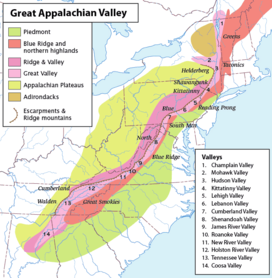| Allegheny Front | |
|---|---|
 Dans Mountain, part of the Allegheny Front in Maryland | |
| Highest point | |
| Peak | Mount Porte Crayon, Randolph/Pendleton Co. border, West Virginia |
| Elevation | 4,774 ft (1,455 m) |
| Coordinates | 38°55′44″N 79°27′22″W / 38.92889°N 79.45611°W |
| Geography | |
 The Allegheny Front is west of the Cumberland Valley and is part of the Appalachian escarpment extending between the Helderberg Escarpment in New York to Walden Ridge in Tennessee. | |
| Country | United States |
| States |
|
| Range coordinates | 39°04′23″N 79°17′53″W / 39.07306°N 79.29806°W |
| Parent range | Allegheny Mountains of the Ridge-and-Valley Appalachians |
| Geology | |
| Orogeny | Alleghenian orogeny |
The Allegheny Front is the major southeast- or east-facing escarpment in the Allegheny Mountains in southern Pennsylvania, western Maryland, eastern West Virginia, and western Virginia. The Allegheny Front forms the boundary between the Ridge-and-Valley Appalachians to its east and the Appalachian Plateau (locally called the Allegheny Plateau) to its west. The Front is closely associated with the Appalachian Mountains' Eastern Continental Divide, which in this area divides the waters of the Ohio/Mississippi river system, flowing to the Gulf of Mexico, from rivers flowing into Chesapeake Bay and from there into the Atlantic Ocean.
The Allegheny Front and the Eastern Continental Divide do not always coincide; for example, the North Branch of the Potomac River begins well west of the Front, at the Fairfax Stone near the southwestern tip of Maryland, about 10 miles (16 km) and across the actual divide from the headwaters of the Youghiogheny River draining northwards into the Monongahela and Ohio rivers.
The Allegheny Front is one of the windiest spots east of the Mississippi, leading to the recent establishment of wind farming there.[citation needed]
